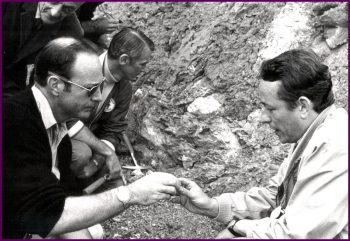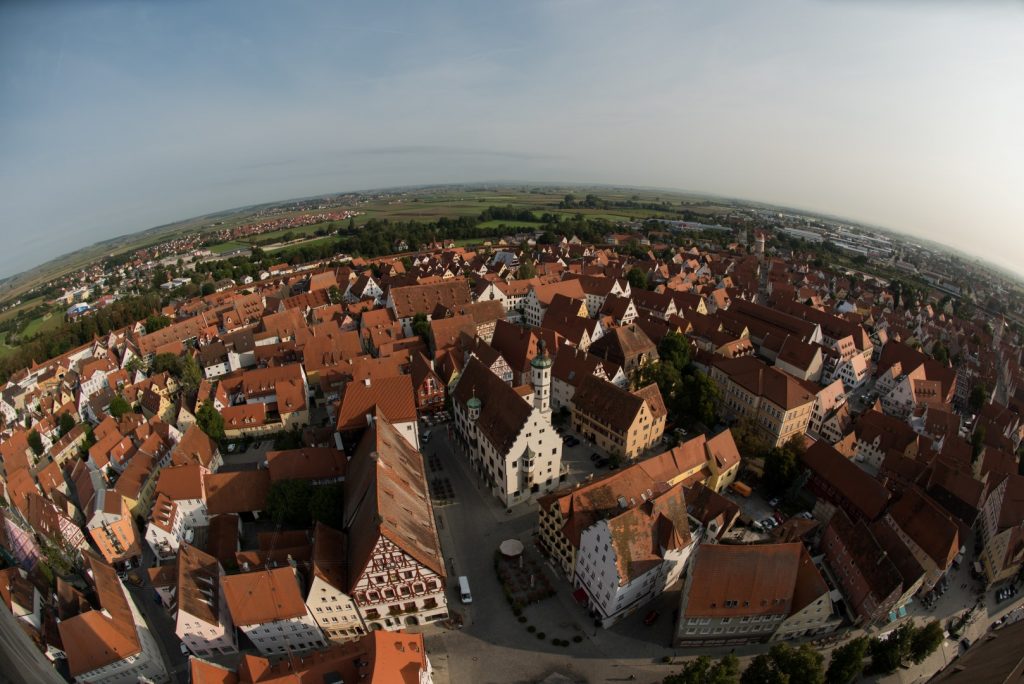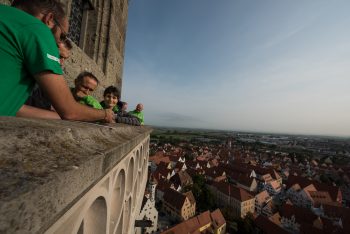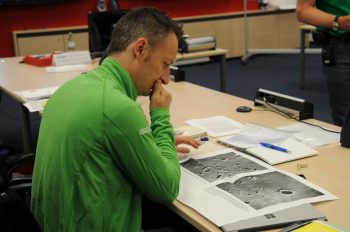With a steady pace we’re heading for the top of Nördlingen’s church tower. “Look at the shiny steps of the staircase!”, points out our instructor Francesco Sauro. The view from the belfry is more than rewarding for the strenuous way up: Nördlingen is a beautiful town in the middle of the triangle Nürnberg – Stuttgart – Munich in Bavaria, Germany. The medieval town-wall is circular and only has a slightly smaller diameter (1 km) than the meteorite (1,2-1,5 km) that fell from the sky and hit this place 15 million years ago. The result of this impact is still visible today: a crater that was initially around 28 km in diameter and almost one kilometre deep. Today a diameter of 25 km remains with a 500 m high rim.
The statistics of this infernal event are impossible to grasp: 15-20 km/s of impact velocity, maximum temperature during the impact of up to 30 000°C, energy released during the impact 1020-1021 Joule. Or 1 trillion times the energy of the Hiroshima atomic bomb (56 TJ). The view from the belfry translates this into a sensation, a glimpse of understanding, of the incredible forces nature exerted here. “We are confident to have a good understanding of the orbits of most asteroids above 3 km diameter.”, explains Prof. Harry Hiesinger “but not for all smaller objects that may fall down on us as meteorites.”
How comforting. I remember from my Introduction to space debris class that meteorites larger than 1-2 km in diameter hitting our planet are likely to cause global effects. I take a mental note to learn more about ESA’s space situational awareness programme and how to track objects in space.

Apollo 14 field trip to Nördlingen Ries. From the left: Professor Wolf von Engelhardt, Dr. Ed Mitchell, Gene Cernan, and Dr. Stöffler. Credits: NASA
But back to Nördlingen and its Ries crater. We are here for astronaut training I need to remind myself. And indeed, we are not the first astronauts who came here to do so. Almost 47 years ago, in the summer of 1970 the crews of Apollo 14 and 17 chose to study the Ries crater only months before their flight to the Moon because it is one of the best-preserved impact craters on Earth. Initially it was believed to be a volcanic crater until NASA geologists found high-pressure modifications of quartz (Harry calls them “Coesite” and “Stishovite”) and the shiny micro-diamonds Francesco pointed out on the belfry steps. These mineralogical clues are indisputable evidence that a meteorite formed this crater.
Not many impact craters of this beauty remain on Earth. Weathering and erosion, volcanic activity and plate tectonics and nature continuously rework the surface of our planet. But the Moon is different. There is no atmosphere, no active volcanoes or plate tectonics. Nor anything alive on its surface. This dead body has an open record of the last 4 billion years of our solar system, carved in its surface. A pure treasure trove for planetary scientists who work on understanding and modelling the evolution of our solar system. A first step to understanding our galaxy and the universe beyond. And the future that lays ahead of our tiny planet.
Reading and understanding lunar geology and especially the Moon’s impact craters is key to decoding this mystery. A challenging task for the geologists back on earth. They need the astronauts picking up the right samples, forming the best descriptions of what they see and observe. Astronauts will be their eyes and hands on the Moon – and since skilled eyes and hands do a better job we are here in the Ries crater on ESA’s Pangaea geological field trip.
Matthias Maurer




Discussion: 2 comments
Your doing awesome work. Thanks for sharing your knowledge with all of us
Multiple sensors on automatic stations and mobile platforms would be better eyes for the geologists. Astronauts on the Moon are a irrational and very inefficient approach to the study of the solar system.